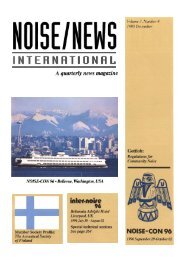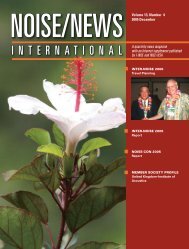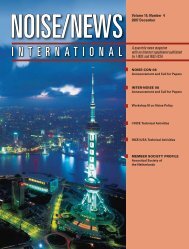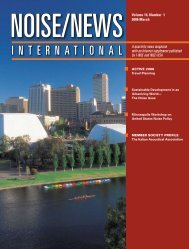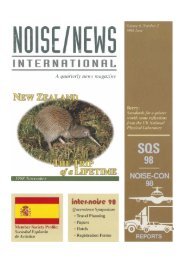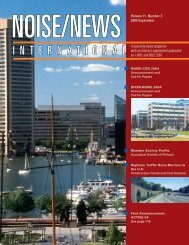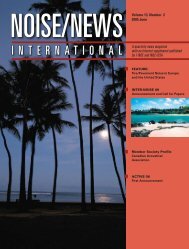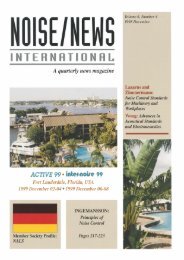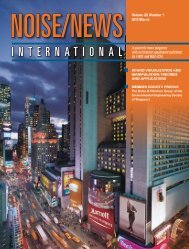Volume 4, Number 1, March, 1996 - Noise News International
Volume 4, Number 1, March, 1996 - Noise News International
Volume 4, Number 1, March, 1996 - Noise News International
- No tags were found...
You also want an ePaper? Increase the reach of your titles
YUMPU automatically turns print PDFs into web optimized ePapers that Google loves.
acoustical environment and the promotion of relatedknowledge. The ASTM is not a professional societyin the usual sense, nor is it a trade association. It isa unique organization founded nearly a century agoto promote the development of standards on a broadrange of subjects related to materials, products, systemsand services. The Society currently has 37,000members. Its standards are published in the AnnualBook ofASTM Standards.ASTM E-33 on Environmental Acoustics has139 members and holds two meetings a year of themain committee and its subcommittees. E-33 hasnine technical subcommittees:• E-33.01 on Sound Absorption - the developmentof test methods and specifications for thesound absorption and other physical properties ofmaterials, products, and systems as designed orused for the absorption of airborne sound.• E-33.02 on Open Plan Spaces - the developmentof test methods and practices relating to materials,products and systems used for the control ofacoustics in open plan spaces, such as offices,schools, etc.• E-33.03 on Sound Transmission - the developmentof standards dealing with the sound transmissioncharacteristics and performance ofmaterials, products, and systems relating to theacoustical environment and the response thereto.• E-33.04 on Application of Acoustical Materialsand Systems - the development of standards forinstallation and use of acoustical materials, productsand systems that will lead to predictableperformance in buildings.• E-33.05 on Research - the development of testprocedures common to two or more test standards;the establishment of guidelines for the metricationof E-33 standards; the coordination ofresearch projects aimed at improving E-33 testprocedures; and the publication of test and researchinformation developed by E-33.• E-33.06 on <strong>International</strong> Standards - this subcommitteeis the U.S. Technical Advisory Groupfor ISO/TC43/SC2 on Building Acoustics.• E-33.07 on Definitions and Editorial- nomenclature,definitions, units and symbols.• E-33.08 on Mechanical and Electrical System<strong>Noise</strong> - the development of standards dealingwith the noise produced by mechanical and elec-trical equipment associated with buildings andindustrial installations.• E-33.09 on Community <strong>Noise</strong> -preparation)(scope underIn recent years, the ASTM has made a concertedeffort to internationalize its standards and to seektheir adoption outside the USA. The U.S. Governmenthas adopted a "hands-off' policy with respectto the development of standards. This is a uniqueposition as the governments of all other countriesparticipate in standards development by providingfunding for their standards organizations. Standardsdevelopment is strictly a voluntary process in theUSA with no governmental funding. This situationhas lead to a continuing debate between ANSI andASTM over the rights to issue American NationalStandards and to represent the USA to the standardsdevelopingbodies overseas.The activities of ASA, SAE and ASTM in thedevelopment of acoustical standards have been describedin some detail. But these three are not theonly organizations preparing acoustical standards inthe USA. There are more than 20 other organizationsthat have produced one or two standards on noise.These other organizations are closely related to differentproducts, and the standards they produce areusually concerned with the particular class of productsof interest to the preparing organization. A fewof these product standards that have been developedaccording to ANSI procedures have been recognizedas American National Standards.The Audio Engineering Society is also active inthe development of standards, but none of its publishedstandards relates to noise and its control.Other OrganizationsThe National Council of Acoustical Consultants(NCAC) has member firms throughout the USA andCanada (90%), as well as international memberfirms (10%). NCAC is not a technical organization,but rather a council of nearly 150 member firmsrepresenting some 400 to 500 individuals who provideconsulting services in all branches of acoustics.NCAC was founded in 1962 and will celebrate its35th anniversary in 1997. NCAC promotes the businessneeds of the profession and the general welfareof the individual consultants.Approximately 40 percent of the member firmsare one or two person organizations including manyuniversity professors, with the remaining firms havingup to 20 or more individual consultants. Thelargest firm has more than 50 individual consultants.The university professors assist in advancing thetechnical knowledge of acoustics within the consult-14<strong>Noise</strong>l<strong>News</strong> <strong>International</strong><strong>1996</strong> <strong>March</strong>



